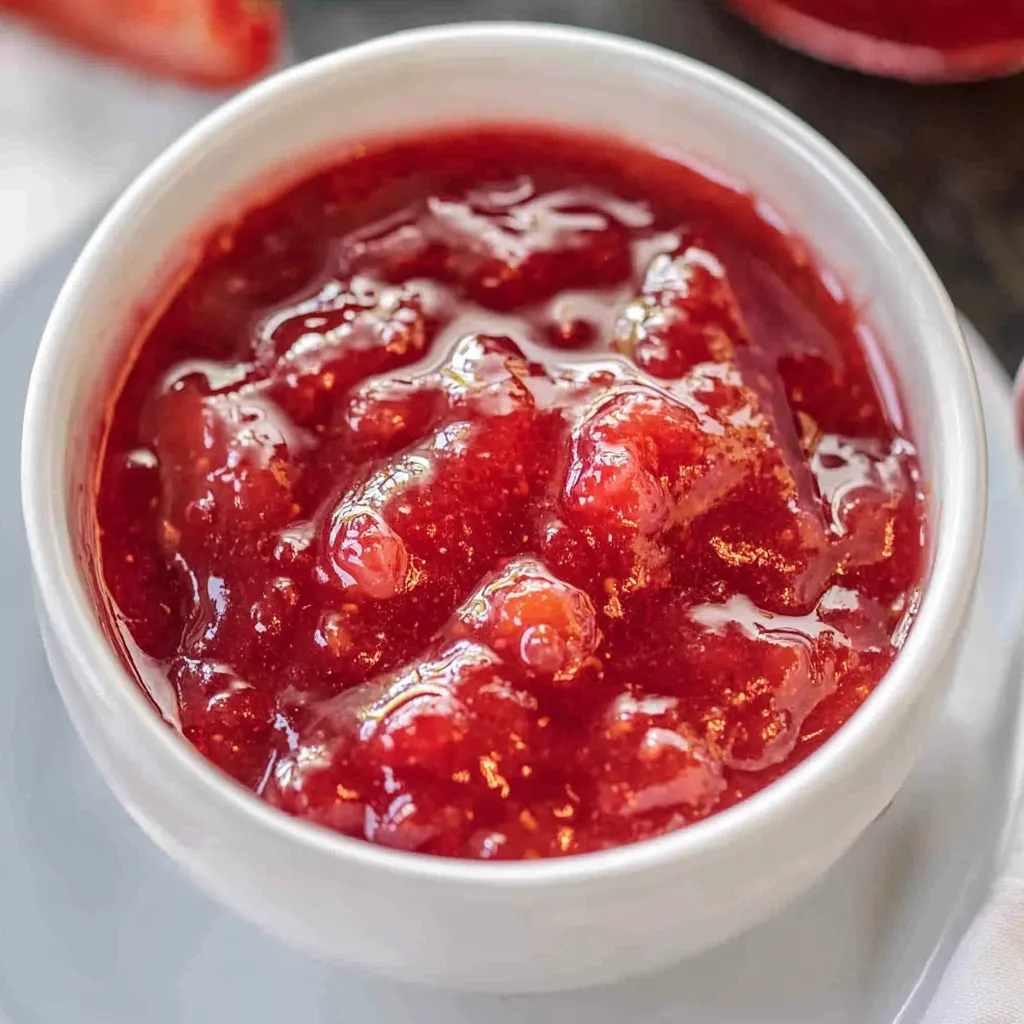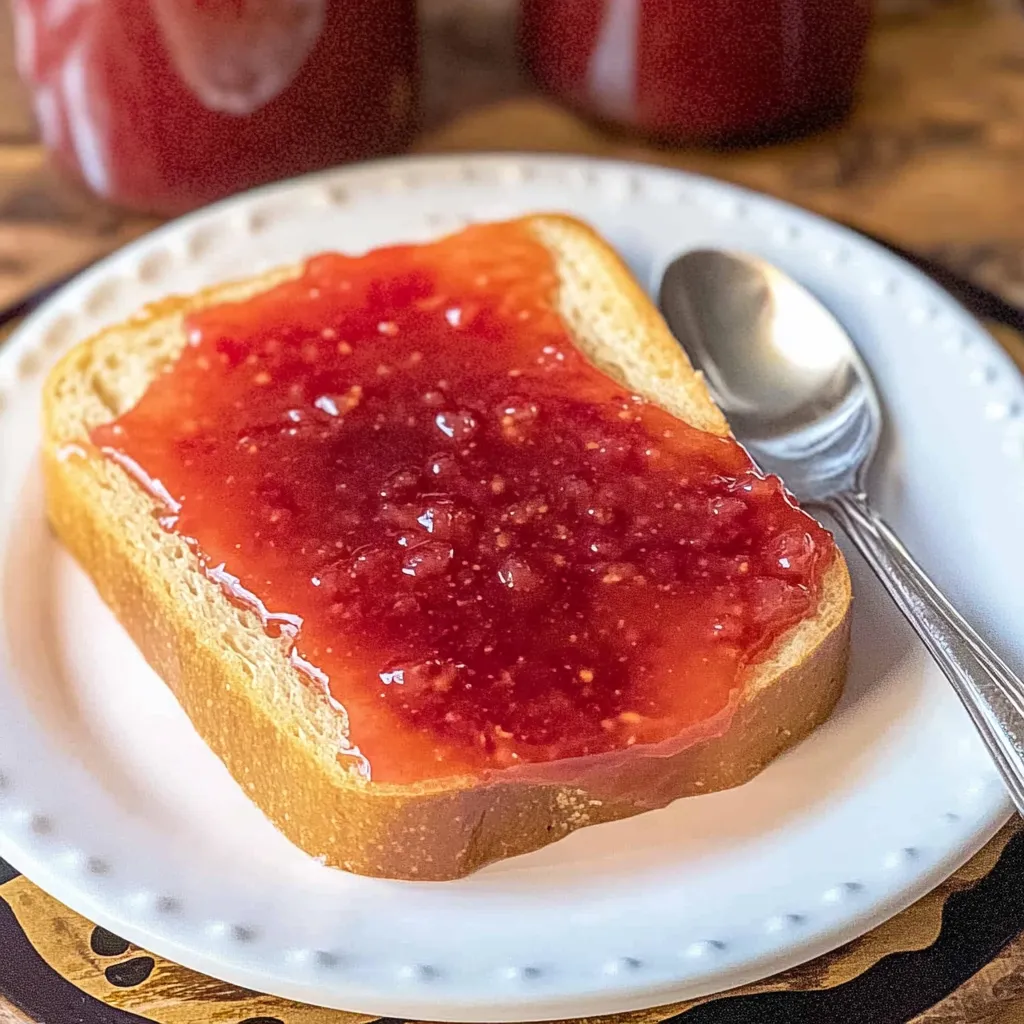 Pin it
Pin it
This bright, vibrant strawberry rhubarb jam captures the perfect balance between sweet strawberries and tart rhubarb in a small-batch recipe that's ideal for beginners or anyone who wants to make just enough to enjoy without committing to large-scale preserving. The combination of fresh fruit flavors concentrated through gentle cooking creates an intensely delicious spread that tastes infinitely better than store-bought versions, while the use of powdered pectin ensures perfect set every time without guesswork. Unlike complicated jam recipes that require large quantities and advanced canning knowledge, this approachable method produces just two jars of restaurant-quality jam using simple techniques that guarantee success.
I started making this jam when I moved to an area where rhubarb grows abundantly and wanted to understand what made this vegetable so beloved in traditional cooking. The first batch I made was a revelation - the way rhubarb's tartness balanced the strawberries created something much more interesting than plain strawberry jam, and now I make this every spring as soon as both ingredients are in season.
Essential Ingredients and Selection Tips
- Fresh strawberries: Choose berries that are fully ripe and fragrant; taste them first to gauge sweetness as this affects the final flavor balance
- Fresh rhubarb: Select firm, crisp stalks; the color doesn't matter much since strawberries will dominate the final color
- Powdered pectin: Buy pectin in jars rather than packets for easier measuring and storage; fresh pectin ensures proper setting
- Granulated sugar: Use exactly the amount specified as sugar works with pectin for proper gel formation; substitutions may prevent setting
- Lemon juice: Fresh or bottled both work well; the acid helps pectin activation and adds brightness to balance the sweetness
The secret to perfect jam consistency is following the timing exactly - the one-minute rolling boil is crucial for proper pectin activation and gel formation.
Detailed Step-by-Step Instructions
- Step 1: Prepare your containers:
- Set two clean 8-ounce mason jars on a kitchen towel-lined counter. Having them ready prevents scrambling to find containers while dealing with hot jam, and the towel catches any spills during filling.
- Step 2: Measure sugar in advance:
- Place the granulated sugar in a bowl and set aside where you can easily reach it. Having it pre-measured and ready ensures you can add it quickly when the time comes during the cooking process.
- Step 3: Prepare the strawberries:
- Remove stems and quarter 8 large strawberries, placing them in a bowl. Using a potato masher or large fork, crush the berries until you have a chunky mixture with released juices. Measure exactly ⅔ cup of this mixture, including all the juices.
- Step 4: Prepare the rhubarb:
- Wash the rhubarb stalks and trim both ends, then dice into small ¼-inch pieces. The small size ensures even cooking and proper breakdown during the jam-making process. Measure exactly ⅔ cup of diced rhubarb.
- Step 5: Combine fruits and start cooking:
- Place both the measured strawberries and rhubarb in a wide, shallow saucepan. Add the lemon juice and sprinkle the powdered pectin evenly over the fruit. Stir everything together until the pectin is well distributed.
- Step 6: Initial cooking phase:
- Set the pan over medium heat and cook, stirring constantly, until the pectin dissolves completely and the fruit begins breaking down and releasing juices. The mixture should start bubbling and become quite liquid as the fruit softens.
- Step 7: Add sugar quickly:
- When the fruit mixture is bubbling actively, add all the pre-measured sugar at once and stir vigorously to incorporate it completely. Make sure to scrape the bottom of the pan to prevent any sugar from sticking and burning.
- Step 8: Achieve rolling boil:
- Continue cooking while stirring constantly until the mixture reaches a rolling boil that cannot be stirred down - the bubbles should continue vigorously even when you stir through them. This is the critical point for proper jam setting.
- Step 9: Final boiling phase:
- Once you achieve the rolling boil, maintain it for exactly 1 minute while stirring constantly. This timing is crucial for proper pectin activation - too little time won't set properly, too much can break down the pectin.
- Step 10: Finish and jar:
- Remove from heat immediately after the 1-minute boil. Skim off any foam if desired for clearer appearance, then carefully ladle the hot jam into prepared jars, leaving ¼-inch headspace. Wipe jar rims clean with a damp cloth.
- Step 11: Cool and store:
- For refrigerator storage, place lids loosely on jars and let cool completely before tightening and refrigerating. For pantry storage, process in a boiling water bath for 10 minutes using proper canning procedures.
 Pin it
Pin it
The most critical technique is maintaining that rolling boil for exactly one minute - this precise timing ensures the pectin activates properly to create the perfect jam consistency.
This jam recipe has become my proof that homemade preserves are always worth the small effort required because the flavor difference from store-bought versions is absolutely dramatic. My mother-in-law, who's quite particular about jams, declared this better than anything she'd ever bought and asked me to teach her the technique.
Understanding Jam Science and Pectin Activation
Successful jam-making relies on the interaction between pectin, acid, and sugar to create the gel structure that gives jam its spreadable consistency. Pectin molecules form networks when heated in the presence of adequate sugar and acid, trapping water and fruit pieces in a stable gel. The rolling boil stage is crucial because the high temperature activates the pectin while the timing prevents over-processing that can break down the gel structure. Understanding this science explains why precise measurements and timing are so important for consistent results.
Fruit Preparation and Flavor Development
The way you prepare fruit significantly affects both texture and flavor in the finished jam. Crushing strawberries releases their juices and creates varying textures from smooth puree to identifiable pieces, while small rhubarb dice ensures even cooking and proper breakdown. The initial cooking phase without sugar allows fruit enzymes to work on breaking down cell walls, which develops more complex flavors than simply cooking everything together from the start. This technique also helps achieve proper texture balance between the two different fruits.
Heat Management and Cooking Techniques
Proper heat control is essential for developing jam flavor while preventing scorching or uneven cooking. Medium heat allows gradual warming that dissolves pectin evenly, while the final high heat stage creates the rolling boil necessary for gel formation. Wide, shallow pans work better than deep pots because they allow faster moisture evaporation and easier monitoring of the cooking process. Constant stirring prevents hot spots that can burn the fruit and create off flavors.
Sugar's Multiple Functions
Sugar serves several critical functions in jam beyond sweetening - it works with pectin to create gel structure, helps preserve the finished product, and affects texture development. The amount of sugar specified is calculated to work with the pectin and acid levels for proper setting, which is why substitutions often fail. Sugar also helps maintain fruit structure during cooking and contributes to the glossy appearance that characterizes good jam.
Storage Options and Safety Considerations
This recipe offers flexibility between simple refrigerator storage and proper canning for pantry storage. Refrigerator jam relies on the jam's acidity and sugar content for short-term preservation, while water bath canning creates shelf-stable products through heat processing that destroys harmful microorganisms. Understanding the difference helps you choose the storage method that matches your needs and comfort level with home preservation techniques.
This strawberry rhubarb jam has taught me that some of the most rewarding cooking projects are those that connect you to seasonal ingredients and traditional techniques while creating something that simply cannot be purchased. Every time I make it, I'm reminded that understanding basic food science principles allows you to create consistent, professional results while developing the confidence to eventually experiment and make recipes your own.
Frequently Asked Questions
- → How long does homemade strawberry rhubarb jam last?
- Store in the refrigerator for up to 3 weeks. For longer storage, you can process in a water bath canner for 10 minutes.
- → Can I use frozen strawberries and rhubarb?
- Yes, frozen fruit works well. Thaw completely and drain excess liquid before using to prevent watery jam.
- → Why do I need pectin for this jam recipe?
- Pectin helps the jam set properly and reach the right thickness. Without it, your jam may stay too runny.
- → What if my jam doesn't thicken enough?
- Cook for an extra minute or two. The jam will also thicken more as it cools. Test by dropping a spoonful on a cold plate.
- → Can I reduce the sugar in this recipe?
- Sugar helps preserve the jam and aids in setting. You can reduce it slightly, but the texture and shelf life may change.
- → What's the best way to serve strawberry rhubarb jam?
- Great on toast, biscuits, scones, or stirred into yogurt. Also works well as a topping for pancakes and waffles.
